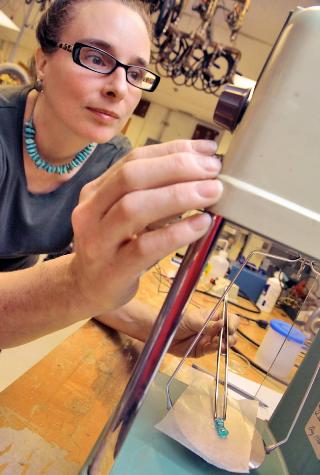Apr 10 2015
Lenore Rasmussen’s Synthetic Muscle™ material will be launched to the International Space Station by a Falcon 9 rocket on April 13, 2015 from Cape Canaveral in Florida.
 Lenore Rasmussen working in a laboratory at the Princeton Plasma Physics Laboratory. (Photo by Elle Starkman/PPPl Office of Communications)
Lenore Rasmussen working in a laboratory at the Princeton Plasma Physics Laboratory. (Photo by Elle Starkman/PPPl Office of Communications)
The novel, gel-like material is an electroactive polymer capable of simulating the movement of muscles in humans. This is due to its ability to expand and contract, which makes it a potential material to develop more responsive robots and better prosthetic limbs. It exhibits rubber-like hardness and jelly-like softness.
Rasmussen created the Synthetic Muscle™ at her RAS Labs, which she founded in 2003. In 1998, she was awarded the first patent for the novel material. She started working with the Princeton Plasma Physics Laboratory (PPPL) of the U.S. Department of Energy in 2007.
With the help of scientists at PPPL, Rasmussen has further developed the material to make it to adhere to metal. The outstanding radiation resistance characteristics of the Synthetic Muscle™ make it a potential material for use in robotics in deep space travel such as a Mars mission.
“Based on the good results we had on planet Earth, the next step is to see how it behaves in a space environment,” said Charles Gentile, a PPPL engineer who has worked closely with Rasmussen. “From there the next step might be to use it on a mission to Mars.”
“We can’t explore space without robots,” Rasmussen said. “Humans can only withstand a certain amount of radiation so that limits the time that people can be in space, whereas robots particularly if they’re radiation-resistant can be up there for long periods of time without being replaced.”
Lew Meixler, a former head of Technology Transfer at PPPL, helped Rasmussen to accomplish her project. “That’s what entrepreneurs are,” he said. “They’re the dreamers who devote all their time, energy and resources to follow their dreams.”
Rasmussen thanks PPPL for providing the necessary support during key stages of her project. “It was and continues to be a wonderful resource not just because of the plasma physics but the people,” she said. “Charlie and Lew found ways to make things happen.”
At PPPL, Rasmussen made the gel adhere to the metal electrodes. With the help of Lew Meixler on a federal Cooperative Research and Development Agreement in the Plasma Surface Laboratory, she achieved this feat by subjecting metal, such as titanium or steel, to a plasma treatment. This changed the surface of the metal and left the material with the ability to adhere more closely to the metal.
Last summer, the material was subjected to a chain of tests, including exposure to more than 300,000 RADs of gamma radiation. This value is 20 times higher than the unsafe level for human exposure to gamma radiation. This exposure level is equivalent to that which one would encounter in a Mars mission. The material was tested for 45 hours, which is equivalent to a mission to Jupiter and beyond.
From the test results, Rasmussen and Gentile determined that the material was able to maintain its electroactivity, strength, and durability, but experienced a slight color change. Experiments on selected samples of the Synthetic Muscle™ revealed that the material remained unchanged even at extreme temperatures down to -271°C. This value is in the proximity of absolute zero, which is the coldest temperature achievable in the universe.
Since the successful completion of the tests, PPPL researchers have been planning for the launch. Many PPPL engineers, and Rasmussen and her staff, have put their signatures on the back of the metal container or coupon carrying the material. “All of the people who worked on the lab signed it and the coupon will go into space,” said Gentile. “So I’ll be up there with Gene Roddenberry.”
The Dragon, which will be launched to the International Space Station National Laboratory by the Falcon 9 rocket, will carry 4,300 pounds of payloads and supplies, including material for experiments. It will be propelled into the orbit by the nine-engine rocket and will meet with the Space Station 33 hours after its launch. The Dragon will be captured by the astronauts using the 57-foot arm of the station on April 15 at 7:15 a.m.
At the International Space Station National Laboratory, the material will be maintained in a zero gravity storage rack for 90 days and images of the material will be taken every three weeks. On returning to Earth in July 2015, the material will be subjected to testing for comparison with identical materials that remained on Earth.
Rasmussen is also studying the possibility of using the Synthetic Muscle™ as a prosthetic liner. During the day, amputees’ vestigial limbs can expand and contract, and more comfortable prosthetics could be made from the Ras Labs material due to its ability to expand and contract. The Pediatric Medical Device Consortium at the Children’s Hospital of Philadelphia recently awarded a grant to Rasmussen for this work.